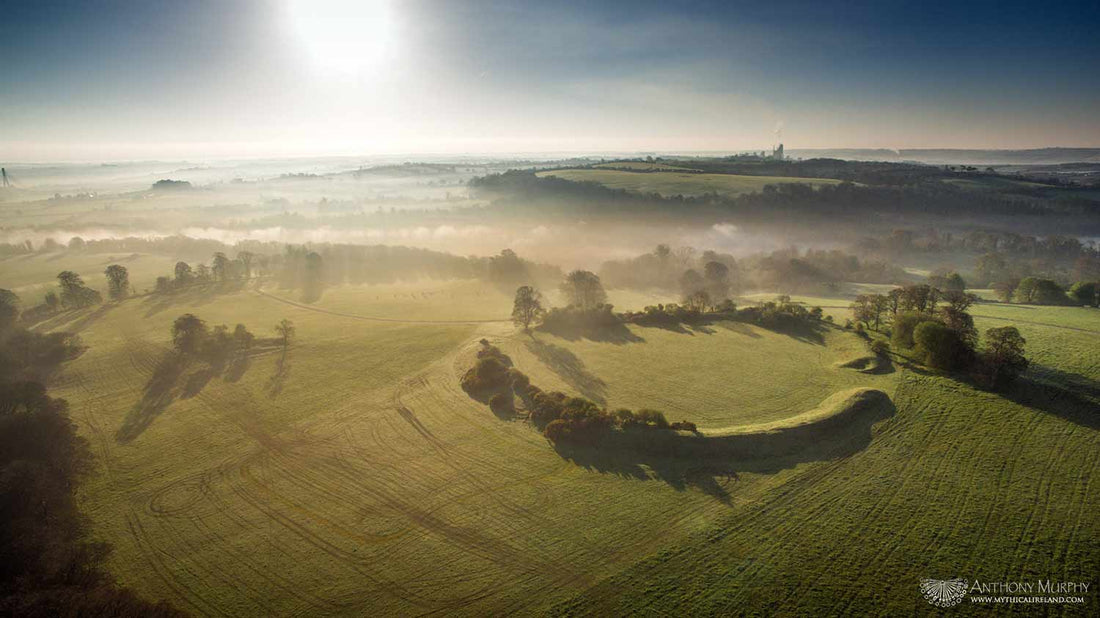
I think I might have found the Irish word for a henge
Recently, a friend asked me how many people might have been involved in building Dronehenge[1] and the Late Neolithic monuments of Brú na Bóinne.
Without a moment’s hesitation, I said: ‘Ten thousand’. He asked if that was perhaps too generous an estimate. I explained a few things to him which he might not have been aware of. The number of posts, for instance, in the Great Palisade[2] alone had to number least in the hundreds, probably the thousands.

Great Palisade post holes in crop marks at Brú na Bóinne. Image © Anthony Murphy
And taking into account the number of monuments, and all the features of those monuments that had to be dug out by hand, using stone and bone tools, it was certainly not the sort of construction project that could be achieved by a mere few hundred labourers, unless the whole thing had taken decades to complete.
All the indications are that the mound-building phase at Brú na Bóinne had been at least a regional project, requiring labour that had come to the Bend of the Boyne in large numbers from elsewhere.[3] We now know – thanks largely to the discoveries of 2018 – that the Late Neolithic phase was at least as impressive in scale, and perhaps more so, than that mound-building period.

My own illustration showing the visible features of 'Dronehenge' drawn on a vertical aerial photograph of the site taken by Ken Williams.
Now my guess of 10,000 workers might be on the generous side, but if all those monuments were standing at the same time – and the fact that they respect each other’s boundaries suggests that they were[4] – my own view is that the workforce involved must at least have numbered one thousand. However, because a lot of wood was used, and wood is quite an impermanent material, I would think that the monuments which used wood as a principal source material had been constructed in a relatively short time span, probably something of the order of a few years.
It is highly unlikely in my opinion that a locally-based and relatively small population could have completed something on this scale in a short time frame without outside help. Just how many people might have been required is a matter of some conjecture, and although myth is not necessarily a reliable source of ‘data’ about these things, the fact that the legend of Dowth says that the king brought ‘all the men of Erin’[5] to that place to build his mound may give some indication of the sort of input of manpower that might have been required for what appears to be the largest and most complex Late Neolithic monument assemblage not just in Ireland, but probably in Europe.

The legend of Dowth says that it was built by 'All the men of Erin'.
One person who I think knows more than most about the Late Neolithic phase at Brú na Bóinne is Dr. Steve Davis of University College Dublin. In 2022, I told him about my workforce estimate. His answer gave me something of a surprise, because it provided me with information which I had been unaware of while making my calculations (well, it was a quick estimate, not really a proper calculation).
Here’s what he said: ‘A back-of-the-envelope calculation on how many posts in the [Great] Palisade reckons c. 4,000. It’s a big job.’[6]

The Great Palisade and other features at Brú na Bóinne. Image: National Monuments Service
I hadn’t realised just how many post holes there were in the Great Palisade. Each of those was likely to have been around a metre to a metre and a half deep, and up to a metre wide.[7] When you consider that they were all dug out using cow scapula shovels and antler picks[8] (they were excavated before metal tools were available), each one would have presented a considerable task of manual labour to those who were doing the digging.
There were about 150 post holes visible at Dronehenge in the 2018 drone imagery, but that number is likely to be closer to 200 or even 250 given that a great portion of the post hole circle (circles, actually, because there were two) was invisible on the north-eastern quadrant of the monument.
When we take into account all the ditch segments, the four-poster and other monuments, and the untold labour of cutting down trees and shipping them to Brú na Bóinne, we begin to imagine something of the sheer scale of this project.
How many trees?
Four thousand Great Palisade posts does not necessarily equate to 4,000 trees – it might be the case that each tree bough could provide maybe two or three posts – but a conservative estimate would suggest something of the order of five hundred trees, and perhaps as many as one thousand. Each of those trees had to have been felled with an axe with a stone head. Perhaps someone with enough skill and experience could fell 20 trees a day, but this output would have exacted a severe and punishing toll on the body of the lumberjack.
How many lumberjacks were there? How far away from Brú na Bóinne were the trees that were felled? How did the builders and tree-fellers communicate? What sort of boats might have been used to transport the trees? And if they didn’t come by river, how were they hauled across land? There are so many questions, and so few answers. Was the work seasonal? If so, did it happen during summertime, taking advantage of long daylight hours? What did the builders eat, and who fed them?
Monuments of the living
One of the greatest questions for me is this: why did generations of archaeologists and scholars miss the vital information in mythology that Brú na Bóinne was both a relig (a burial site) and an oenach (an assembly site)? Why their lingering focus on the ‘cult of the dead’, and their apparent indifference to the monuments of the living (the henges)?
I know that question is slightly disingenuous because it has only been since my discovery of Dronehenge that I was prompted to look for possible references to an oenach at Brú na Bóinne. However, I am not a professional scholar. Am I to believe that the scholars ignored, overlooked or didn’t give any credence to the (admittedly scant) references to Oenach in Broga in the myths?
All things being normal, my role in this saga should have been confined to that of discoverer. As a non-specialist, it was hardly either my duty or my right to try to provide some of the answers about the nature, purpose and scale of the Late Neolithic landscape at Brú na Bóinne. That should have been the sole purview of the professionals, the experts. And yet I find myself immensely glad, and indeed wholeheartedly grateful, for that opportunity.
Perhaps it is the unfettered freedom I enjoy as a non-specialist that allows me to ask so many questions. And yet I am not paranoid of archaeologists, like many alternative researchers. In fact, I am in their debt, because whatever questions I have asked of them relating to the monuments have always been answered with courtesy, generosity and professionalism. In any case, perhaps it is unfair of me to expect archaeologists to look for clues about the nature of the Late Neolithic Brú na Bóinne landscape in the myths, because most of them (but certainly not all) know little about those myths, and their discipline teaches them that such myths are ‘late’, i.e. written down ‘late’ (in the medieval period) and therefore unreliable as a source of information about the prehistoric landscape.
However, you cannot dismiss the myths of Brú na Bóinne if you wish to know more about the monuments. Quite apart from the scant and specific references to Oanach in Broga, there are tales such as Tochmarc Étaíne, which I think tell us more about the prehistoric monuments of Brú na Bóinne than we might imagine.

Dronehenge and Site P with Newgrange. A viewer on Newgrange, like Elcmar, would see many or most of the Brú na Bóinne henges.
The playing fields
Take, for instance, one of my own personal favourites – the reference to Elcmar standing on or at Newgrange watching the boys at play in the ‘playing fields’. This is translated from the Irish word cluichimuigh, a compound of two words, cluiche and mag, meaning literally ‘games field’, and translated as ‘sports ground’ in the Dinneen foclóir.[9]
Elcmar was still able to view the youths at play in the Brú when he moved to Cleitech[10] (which best indications suggest was located at or near the site of Rosnaree House). The henges of LP2, Dronehenge and Site P are visible both from Newgrange and Rosnaree House – in the case of the latter, only trees block the view today.
Has Tochmarc Étaíne given the specific word that might have been used in ancient times for the type of monument that we know as a ‘henge’?
The word henge is quite modern, and became attached to Stonehenge in recent centuries. If oenach refers to an assembly site, and thus the monument complex in its entirety, could we be so bold as to suggest that cluichimuigh or cluiche-mag was the term by which these monuments might have been known at least in the Middle Ages, and perhaps much, much earlier? The possibilities are very exciting.
Consideration must be given to the fact that if there were monuments or structures visible from Newgrange that might fit the categorisation of 'playing fields', and if these monuments were large arena-type enclosures, then we should consider the possibility that the cluichimuigh of the written myths of the Middle Ages refer, in fact, to the prehistoric, Late Neolithic henge monuments that can be seen from Newgrange.
There are no such large ampitheatre or stadium-like structures dating to the Middle Ages, i.e. when the myths were written down, evident in the archaeological remnants of Brú na Bóinne.
My view, for what it's worth, is that the playing fields described in Tochmarc Étaín (visible to Elcmar, watching from Síd in Broga/Newgrange) are the Late Neolithic henges on the floodplain of the Boyne. In other words, the mythology written by Christian monks in the 12th century AD remembered manmade features of Brú na Bóinne which had stood and were in use several thousand years earlier.
Text © Anthony Murphy, www.mythicalireland.com, 2023

Footnotes and references
[1] The popular name for a monument in the townland of Newgrange whose footprint was revealed by crop marks during the summer drought of 2018 and discovered by this author.
[2] The name given by the National Monuments Service to a feature revealed by crop marks showing hundreds of post holes or pits arrayed in a wide arc across the middle terrace of the landscape south of the Newgrange monument. See this page for more detail: https://mythicalireland.com/blogs/news/fantastic-new-details-emerge-of-monuments-discovered-near-newgrange-during-2018-drought
[3] See Murphy (2012), Newgrange: Monument to Immortality, Liffey Press.
[4] For a detailed study of the crop mark monument complex photographed in 2018, see Condit, Tom and Keegan, Mark (2018), Aerial investigation and mapping of the Newgrange landscape, Brú na Bóinne, Co. Meath, The Archaeology of the Brú na Bóinne World Heritage Site, Interim Report, December 2018. A PDF version of this report can be downloaded here: https://www.archaeology.ie/sites/default/files/files/bru-na-boinne-interim-report.pdf
[5] Gwynn, Edward (1991) [1924], Metrical Dindshenchas Part IV, School of Celtic Studies, Dublin Institute for Advanced Studies, p. 271.
[6] Dr. Steve Davis, personal communication.
[7] Murphy, Anthony (2019), Dronehenge: The Story Behind the Remarkable Discovery at Newgrange, Liffey Press, p. 132.
[8] Ibid., p. 133.
[9] Dinneen, Rev. Patrick S., (1927), Foclóir Gaedhilge agus Béarla, The Educational Company of Ireland, p. 694. Dinneen renders it cluiche-mhagh.
[10] Elcmar was given the Síd of Cleitech by the Dagda after Oengus had forced him out of Síd in Broga (Newgrange). See Murphy (2019), p. 167.
Further reading on Mythical Ireland
Oenach Oengusa: The games assembly of Newgrange – a hidden gem in the Dindshenchas
Another cropmark discovery at Newgrange Farm: Gateway to another world
The new henge of Newgrange: the moment of discovery recalled
Fantastic new details emerge of monuments discovered near Newgrange during 2018 drought
2020 drought reveals huge amounts of hidden archaeology at Brú na Bóinne

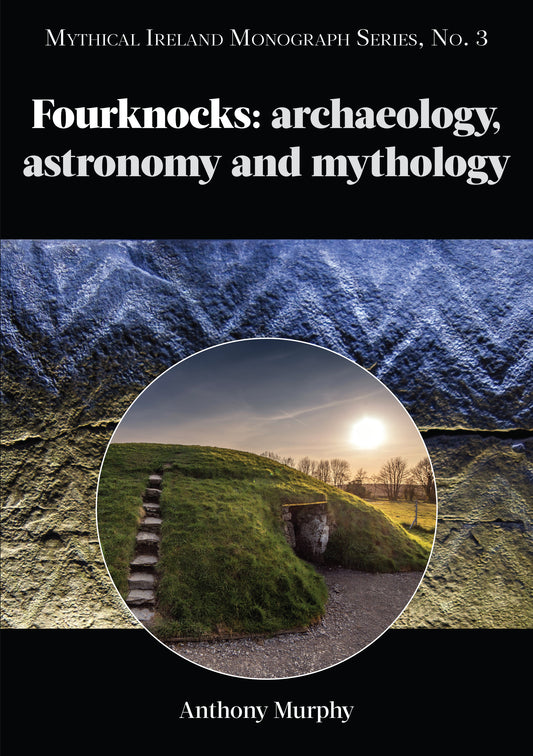
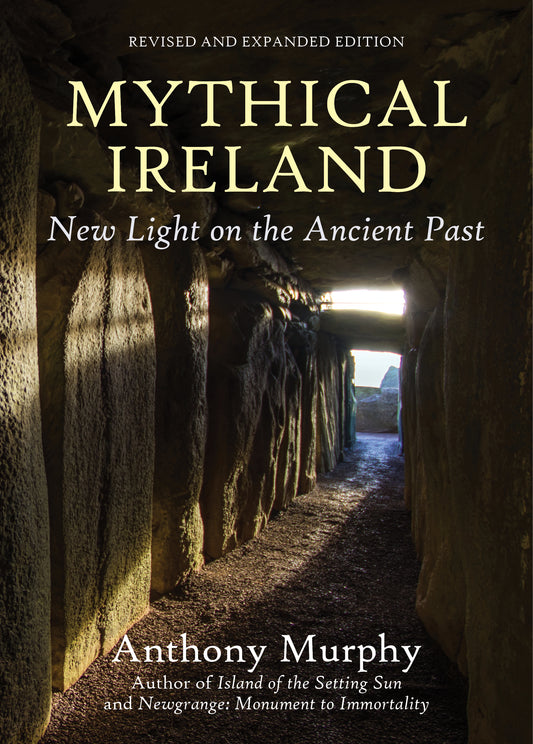
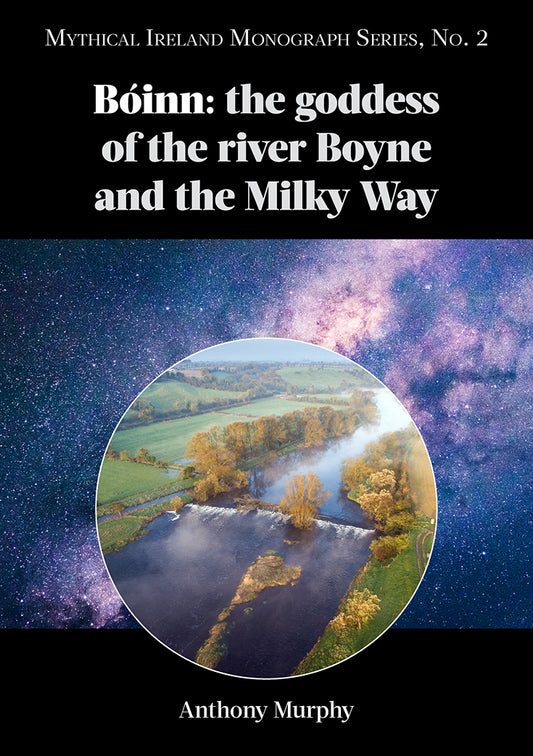
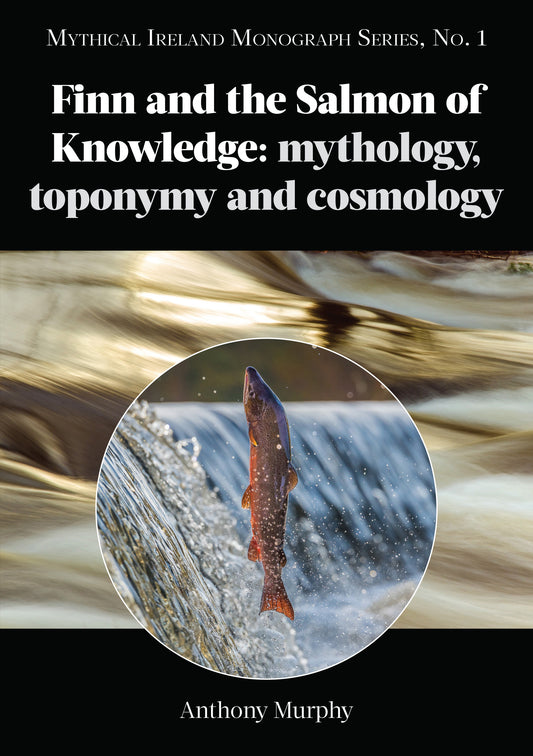
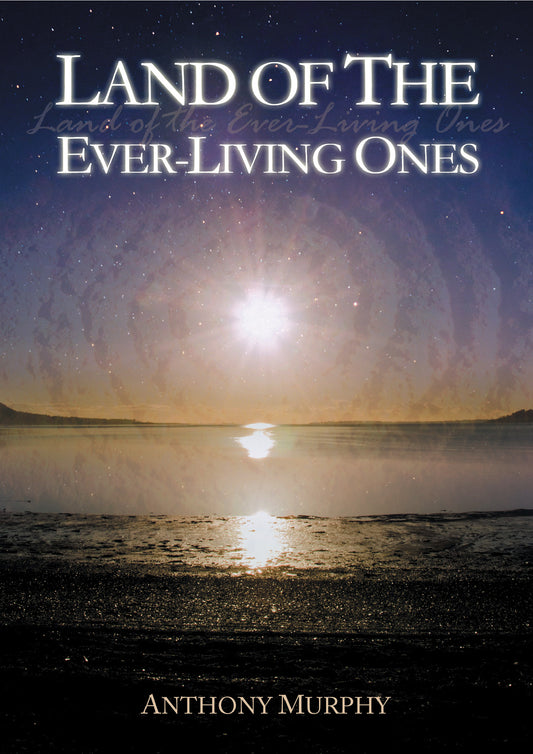
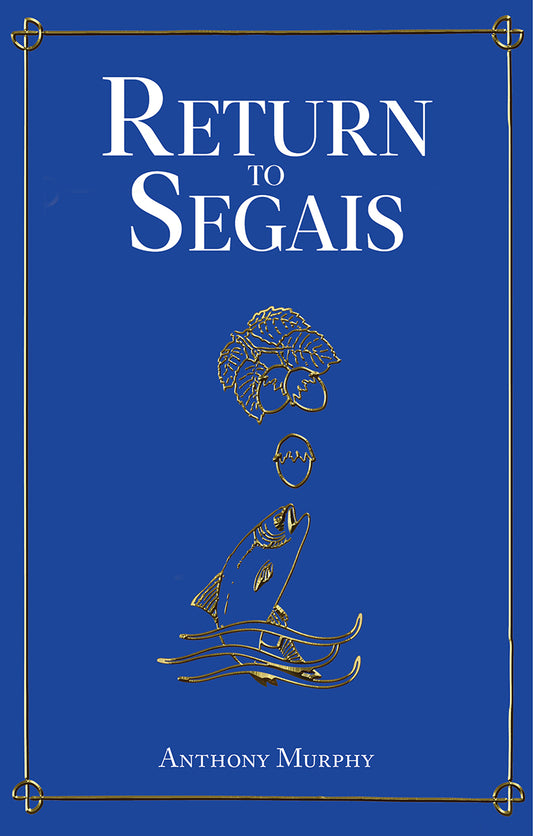
4 comments
Hi Anthony. Informative and well researched as always. By coincidence I read this immediately after listening to this weeks edition of With Great Pleasure in which Melvin Bragg and his archaeologist guests discussed, among other megalith issues, the late Neolithic movement from mounds to henges and the social implications of that change. Thank you for once again tying in the legends and the archeology. Perhaps one day we will find the Boyne equivalent of Dorrington walls to give us a clearer view of the methods used by our ancestors, but I should say that the time team programme on the north Norfolk woodhenge demonstrated just how fast the people of the Neolithic could nap a flint and fell a tree with it. And yes, I think the role of the amateur in bringing in ideas from left field will always be essential
Hi Anthony— I really enjoyed this paper. I just wondered… have you ever done a bit of experiential archaeology and dug a post hole using an antler(s) and cow or deer shoulder bones? I think it would be very interesting to try.
Hi Anthony— I really enjoyed this paper. I just wondered… have you ever done a bit of experiential archaeology and dug a post hole using an antler(s) and cow or deer shoulder bones? I think it would be very interesting to try.
Fascinating. I really enjoyed reading it.